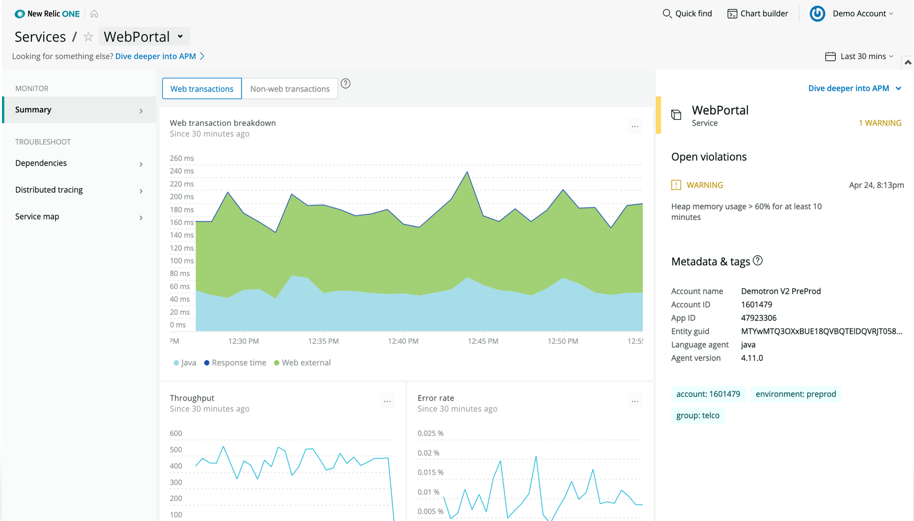New Relic Launches ‘Purpose-Built’ Solution To Help DevOps Teams Better Cope with Complex Apps, Environments
New Relic is offering a ‘purpose-built’ platform to help DevOps teams more easily access the full range of information and data they need to more precisely manage complex apps and environment.

New Relic is offering a ‘purpose-built’ platform to help DevOps teams more easily access the full range of information and data they need to more precisely manage complex apps and environment.
The company’s latest offering, New Relic One, connects all data – and their dependencies and inter-relationships -- in a unified platform. This provides DevOps teams deep and easy access to all the varied information they need (both from IT data and business impact) to manage the performance of their digital systems – from one place.
As app architectures become more complicated in the cloud era, at least one analyst says the time is right for deeper access to various data and their correlations.
With some 40 features, New Relic One is designed to cut through complexity, provide context, and let all members of DevOps teams see end-to-end, according to New Relic CEO Lew Cirne.
This will help them better and more rapidly identify and locate problems -- and resolve them, he added.
New Relic One is the industry's first “entity-centric observability platform,” Cirne added.
One of the advantages of New Relic One is its ability to unify all customer data across multiple accounts – providing teams a “pan-enterprise” view of all of the relationships and dependencies, he said.
Stephen Elliot, program vice president at IDC, said in a statement.
“The demand for microservices and cloud-based services continues to aggravate complications across enterprise technology teams. Untangling these complications requires a thoughtful approach that simplifies the process of observing and measuring software applications. These requirements have never been optional, and are more important than ever as the pace of change accelerates with modern application architectures, DevOps, and Agile approaches.”
Inside the New Relic One Features, Use Cases
New Relic One’s design provides users a unified view across all entities so all team members can understand all major aspects of applications -- from single event traces to end-to-end workflows. Even more helpful, New Relic One can present a shared view of everything team members instrument.
Technically, New Relic One’s pan-enterprise technologies to detect and display information fuels a number of enriched visualizations. For example, the platform offers:
New “cross-account Service Maps,” which can automatically visualize dependencies (up-and down-stream) of entities. This visual view makes troubleshooting – and even root causes analysis - faster and easier.
New and improved dashboarding capabilities to let users quickly create custom dashboards that can connect technical and business details. In other words, technical DevOps teams members can easily visualize how a certain bug or dependency can affect the business impact of an app.
A new ‘chart builder’ feature that lets users quickly create powerful queries, using only a point-and-click curated tool. [This feature complements the New Relic Query Language (NRQL)]. Customers’ existing dashboards in New Relic Insights will automatically appear in New Relic One for viewing and editing.
Visualizations for business- and domain-specific needs. For example, New Relic One makes it is easy to combine store point-of-sale system data with real-time telemetry. All this can be overlaid on a map. Operations teams can see a bird’s-eye view of their store performance across a geographic area, and they can also drill down to see the performance of a specific store that’s giving off an alert.
New Relic One’s approach to providing a ‘unified’ view of more of the diverse DevOps items and points of information is becoming crucial in today’s complicated (and distributed) application architectures, Cirne noted.
“For modern software teams, there are numerous challenges to successfully managing the performance of their increasingly complex environments,” he added. “Many large enterprises have hundreds of siloed teams, responsible for managing interdependent systems. These systems are increasingly complex, often composed of containers or microservices, running on-premise and in the cloud. When service issues arise, teams often struggle to quickly and definitively pinpoint the issue and fix the problem before their customers experience a disruption.”
In short, teams no longer have just 5 or 10 things to monitor, he said. They now must manage thousands or even millions of interdependent items across their environments.
In her post, senior product marketing manager Sara Floss explained New Relic’s One approach to consolidating data into useable visualizations across teams.
New Relic One platform provides a clear, connected view of all your systems, teams, and technology. There is no work or toil involved in establishing and maintaining the relationships among those entities—New Relic One automatically creates and maintains visibility from the data you send us. You can quickly see the entities related to a problem, exposing possible root causes and what other systems might be affected. This lets you speed up troubleshooting, plan changes with confidence, and pinpoint where to optimize performance for the biggest impact on customer experience and other key business outcomes.
An entity is anything that reports data, so you’ll find your entities wherever you see your data reporting in New Relic.
Here’s a quick summary of other New Relic One capabilities:
A connected search and discovery platform: A global search function helps team members find entities across their enterprise quickly.
Easy to use and powerful dashboard: This helps users create information, connect technical efforts and create powerful queries with a point-and-click curated tool.
Extended visualization for business and domain-specific needs: Operation teams can see their store performance across a geographic area. With programmability, New Relic One can be embedded in managing the performance of an enterprise's business.
Unified user experience and global home page: It also delivers a new homepage that enables customers to see all their performance data in one place.
Monitoring for AWS Lambda: Ability to monitor, visualize, troubleshoot, and alert on Lambda functions.
Distributed tracing global search: It also provides a simple and potent tool that helps customers to find traces using custom attributes or tags and teams to work faster when solving performance issues in distributed software environments.

Going to one extra level of drill-down, here’s a taste of New Relic One’s features, and how team members would put them to use:
- Entity summary. Start with a broad view to identifying entities of interest, including their upstream and downstream dependencies. Then, using New Relic diagnostic tooling, users can find the source of problems and locate root causes.
- Relationship API. The GraphQL API lets users retrieve entities (and their inter-relationships), which also speeds up troubleshooting, and where to focus optimization efforts for the biggest impact.
- Distributed tracing global search. Users can find any trace with an attribute—even if only one service within the trace carries the attribute interested in. Or, an ‘advanced search’ lets users search for specifically distributed traces using the advanced search.
Early customer adopters have welcomed New Relic One’s unified platform approach, especially for its ability to offer more data-rich dashboards.
“New Relic One’s improved dashboard capabilities provide much needed visibility into the dependencies across all of the entities we measure. Other tools give me data, New Relic One gives me context. There is great power and comfort in being able to see how cross-functional data is correlated in a centralized platform. When we identify a risk of failure, it is critical that we can pinpoint the root cause rapidly, and New Relic One delivers a whole new level of granularity that helps us,” said Matthew B. Vaughan, lead software engineer at Cox Automotive in Atlanta.






